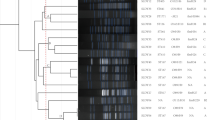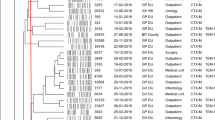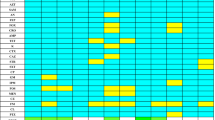Abstract
This study was designed to characterize extended-spectrum beta-lactamase (ESBL)–producing extra-intestinal pathogenic Escherichia coli (E.coli) (ExPEC) associated with urinary tract infections in nine different geographic regions of Zimbabwe over a 2-year period (2017–2019). A total of 48 ESBL-positive isolates from urine specimen were selected for whole-genome sequencing from 1246 Escherichia coli isolates biobanked at the National Microbiology Reference laboratory using phenotypic susceptibility testing results from the National Escherichia coli Surveillance Programme to provide representation of different geographical regions and year of isolation. The majority of ESBL E. coli isolates produced cefotaximase-Munich (CTX-M)-15, CTX-M-27, and CTX-M-14. In this study, sequence types (ST) 131 and ST410 were the most predominant antimicrobial-resistant clones and responsible for the increase in ESBL–producing E. coli strains since 2017. Novel ST131 complex strains were recorded during the period 2017 to 2018, thus showing the establishment and evolution of this antimicrobial-resistant ESBL clone in Zimbabwe posing an important public health threat. Incompatibility group F plasmids were predominant among ST131 and ST410 isolates with the following replicons recorded most frequently: F1:A2:B20 (9/19, 47%), F2:A1: B (5/19, 26%), and F1:A1:B49 (8/13, 62%). The results indicate the need for continuous tracking of different ESBL ExPEC clones on a global scale, while targeting specific STs (e.g. ST131 and ST410) through control programs will substantially decrease the spread of ESBLs among ExPEC.




Similar content being viewed by others
Availability of data and material
The raw data supporting the conclusions of this manuscript will be made available by the authors, without undue reservation, to any qualified researcher. All short reads and assemblies associated with this study are available at NCBI under BioProject: PRJNA721804; individual BioSamples are listed in Supplementary File 3.
References
Peirano G, Pitout JDD (2019) Extended-spectrum β-lactamase-producing Enterobacteriaceae: update on molecular epidemiology and treatment options. Drugs 79(14):1529–1541. https://doi.org/10.1007/s40265-019-01180-3
Centers for Disease Control and Prevention (2019) ESBL-producing Enterobacterales in healthcare settings. Centers for Disease Control and Prevention. https://www.cdc.gov/hai/organisms/ESBL.html. Accessed 11 Apr 2019
Pishtiwan AH, Khadija KM (2019) Prevalence of blaTEM, blaSHV, and blaCTX-M genes among ESBL-producing Klebsiella pneumoniae and Escherichia coli isolated from thalassemia patients in Erbil, Iraq. Mediterr J Hematol Infect Dis 11(1):e2019041. https://doi.org/10.4084/MJHID.2019.041
Brolund A (2014) Overview of ESBL-producing Enterobacteriaceae from a Nordic perspective. Infect Ecol Epidemiol 1:4. https://doi.org/10.3402/iee.v4.24555
Mathers AJ, Peirano G, Pitout JD (2015) The role of epidemic resistance plasmids and international high-risk clones in the spread of multidrug-resistant Enterobacteriaceae. Clin Microbiol Rev 28(3):565–591. https://doi.org/10.1128/CMR.00116-14
Pitout JDD, Finn TJ (2020) The evolutionary puzzle of Escherichia coli ST131. Infect Genet Evol 81:104265. https://doi.org/10.1016/j.meegid.2020.104265
Pitout JD, DeVinney R (2017) Escherichia coli ST131: a multidrug-resistant clone primed for global domination. F1000Res 28(6):F1000 Faculty Rev-195. https://doi.org/10.12688/f1000research.10609.1
Birgy A, Bidet P, Levy C, Sobral E, Cohen R, Bonacorsi S (2017) CTX-M-27-Producing Escherichia coli of sequence type 131 and clade C1–M27, France. Emerg Infect Dis 23(5):885. https://doi.org/10.3201/eid2305.161865
Matsumura Y, Pitout JD, Gomi R, Matsuda T, Noguchi T, Yamamoto M, Peirano G, DeVinney R, Bradford PA, Motyl MR, Tanaka M, Nagao M, Takakura S, Ichiyama S (2016) Global Escherichia coli sequence type 131 clade with blaCTX-M-27 Gene. Emerg Infect Dis 22(11):1900–1907. https://doi.org/10.3201/eid2211.160519
Abrar S, Hussain S, Khan RA, Ul Ain N, Haider H, Riaz S (2018) Prevalence of extended-spectrum-β-lactamase producing Enterobacteriaceae: first systematic meta-analysis report from Pakistan. Antimicrob Resist Infect Control 7:26. https://doi.org/10.1186/s13756-018-0309-1
Hu Y, Matsui YW, Riley L (2020) Risk factors for fecal carriage of drug-resistant Escherichia coli: a systematic review and meta-analysis. Antimicrob Resist Infect Control 9(1):31. https://doi.org/10.1186/s13756-020-0691-3
Peirano G, van Greune CH, Pitout JD (2011) Characteristics of infections caused by extended-spectrum β-lactamase-producing Escherichia coli from community hospitals in South Africa. Diagn Microbiol Infect Dis 69(4):449–453. https://doi.org/10.1016/j.diagmicrobio.2010.11.011
Seni J, Peirano G, Okon KO, Jibrin YB, Mohammed A, Mshana SE, DeVinney R, Pitout JD (2018) The population structure of clinical extra-intestinal Escherichia coli in a teaching hospital from Nigeria. Diagn Microbiol Infect Dis 92(1):46–49. https://doi.org/10.1016/j.diagmicrobio.2018.04.001
Sonda T, Kumburu H, van Zwetselaar M, Alifrangis M, Mmbaga BT, Aarestrup FM, Kibiki G, Lund O (2018) Whole genome sequencing reveals high clonal diversity of Escherichia coli isolated from patients in a tertiary care hospital in Moshi, Tanzania. Antimicrob Resist Infect Control 7(1):1–12. https://doi.org/10.1186/s13756-018-0361-x
Estaleva C, Zimba TF, Sekyere JO, Govinden U, Chenia HY, Simonsen GS, Haldorsen B, Essack S, Sundsfjord A (2021) High prevalence of multidrug resistant ESBL- and plasmid mediated AmpC-producing clinical isolates of Escherichia coli at Maputo Central Hospital, Mozambique. BMC Infect Dis 21(16). https://doi.org/10.1186/s12879-020-05696-y
Kabugo D, Kizito S, Ashok DD, Graham KA, Nabimba R, Namunana S, Kabaka MR, Achan B, Najjuka FC (2016) Factors associated with community-acquired urinary tract infections among adults attending assessment centre, Mulago Hospital Uganda. Afr Health Sci 16(4):1131–1142. https://doi.org/10.4314/ahs.v16i4.31
Clinical and Laboratory Standards Institute (2018) Performance standards for antimicrobial susceptibility testing, 28th ed.; CLSI Supplement Document M100; CLSI: Wayne, PA, USA
Technical Manual Wizard® Genomic DNA Purification Kit Wizard® Genomic DNA Purification Kit [internet] (Wisconsin: Promega Corporation). Available from: https://ita.promega.com/media/files/resources/protocols/technical-manuals/0/wizard-genomic-dna-purification-kit-protocols.pdf. [Cited 2017 September 4]
O’Connor AH, Moon TS (2016) Development of design rules for reliable antisense RNA behavior in E. coli. ACS Synth Biol 5(12):1441–1454. https://doi.org/10.1021/acssynbio.6b00036
Bankevich A, Nurk S, Antipov D, Gurevich AA, Dvorkin M, Kulikov AS, Lesin VM, Nikolenko SI, Pham S, Prjibelski AD, Pyshkin AV, Sirotkin AV, Vyahhi N, Tesler G, Alekseyev MA, Pevzner PA (2012) SPAdes: a new genome assembly algorithm and its applications to single-cell sequencing. J Comput Biol 19(5):455–477. https://doi.org/10.1089/cmb.2012.0021
Gurevich A, Saveliev V, Vyahhi N, Tesler G (2013) QUAST: quality assessment tool for genome assemblies. Bioinformatics 29(8):1072–1075. https://doi.org/10.1093/bioinformatics/btt086
Stamatakis A (2014) RAxML Version 8: a tool for phylogenetic analysis and post-analysis of large phylogenies. Bioinformatics 30(9):1312–1313. https://doi.org/10.1093/bioinformatics/btu033
Kozlov AM, Darriba D, Flouri T, Morel B, Stamatakis A (2019) RAxML-NG: a fast, scalable and user-friendly tool for maximum likelihood phylogenetic inference. Bioinformatics 35(21):4453–4455. https://doi.org/10.1093/bioinformatics/btz305
Rambaut A (2010) FigTree v1.3.1. Institute of Evolutionary Biology, University of Edinburgh, Edinburgh. http://tree.bio.ed.ac.uk/software/figtree/. Accessed 14 Dec 2009
Croucher NJ, Didelot X (2015) The application of genomics to tracing bacterial pathogen transmission. Curr Opin Microbiol 23:62–67. https://doi.org/10.1016/j.mib.2014.11.004
Wirth T, Falush D, Lan R, Colles F, Mensa P, Wieler LH, Karch H, Reeves PR, Maiden MC, Ochman H, Achtman M (2006) Sex and virulence in Escherichia coli: an evolutionary perspective. Mol Microbiol 60(5):1136–1151. https://doi.org/10.1111/j.1365-2958.2006.05172.x
Beghain J, Bridier-Nahmias A, Le Nagard H, Denamur E, Clermont O (2018) ClermonTyping: an easy-to-use and accurate in silico method for Escherichia genus strain phylotyping. Microb Genom 4(7):e000192. https://doi.org/10.1099/mgen.0.000192
Hunt M, Mather AE, Sánchez-Busó L, Page AJ, Parkhill J, Keane JA, Harris SR (2017) ARIBA: rapid antimicrobial resistance genotyping directly from sequencing reads. Microb Genom 3(10):e000131. https://doi.org/10.1099/mgen.0.000131
Liu B, Zheng DD, Jin Q, Chen LH, Yang J (2019) VFDB 2019: a comparative pathogenomic platform with an interactive web interface. Nucleic Acids Res 47(D1):D687–D692
Joensen KG, Tetzschner AMM, Iguchi A, Aarestrup FM, Scheutz F (2015) Rapid and easy in silico serotyping of Escherichia coli isolates by use of whole-genome sequencing data. J Clin Microbiol 53:2410–2426. https://doi.org/10.1128/JCM.00008-15
Roer L, Overballe-Petersen S, Hansen F, Schønning K, Wang M, Røder BL, Hansen DS, Justesen US, Andersen LP, Fulgsang-Damgaard D, Hopkins KL, Woodford N, Falgenhauer L, Chakraborty T, Samuelsen Ø, Sjöström K, Johannesen TB, Ng K, Nielsen J, Ethelberg S, Stegger M, Hammerum AM, Hasman H (2018) Escherichia coli sequence type 410 is causing new international high-risk clones. mSphere 3(4):e00337-18. https://doi.org/10.1128/mSphere.00337-18
Sonda T, Kumburu H, van Zwetselaar M, Alifrangis M, Lund O, Kibiki G, Aarestrup FM (2016) Meta-analysis of proportion estimates of extended-spectrum-beta-lactamase-producing Enterobacteriaceae in East Africa hospitals. Antimicrob Resist Infect Control 5:18. https://doi.org/10.1186/s13756-016-0117-4
Storberg V (2014) ESBL-producing Enterobacteriaceae in Africa - a non-systematic literature review of research published 2008–2012. Infect Ecol Epidemiol 13:4. https://doi.org/10.3402/iee.v4.20342
Muvunyi CM, Masaisa F, Bayingana C, Mutesa L, Musemakweri A, Muhirwa G, Claeys GW (2011) Decreased susceptibility to commonly used antimicrobial agents in bacterial pathogens isolated from urinary tract infections in Rwanda: need for new antimicrobial guidelines. Am J Trop Med Hyg 84(6):923–928. https://doi.org/10.4269/ajtmh.2011.11-0057
Muhammad MH, Swedan S (2015) Molecular and phenotypic characterization of carbapenem resistance and extended spectrum beta-lactamases among urinary Escherichia coli isolates. Int J Sci Technol 5(9):1–8
Ogefere HO, Aigbiremwen PA (2015) Omoregie R (2015) Extended spectrum beta-lactamase (ESBL) producing Gram-negative isolates from urine and wound specimens in a tertiary health facility in southern Nigeria. Trop J Pharm Res 14(6):1089–1094
Peirano G, Pitout JD (2010) Molecular epidemiology of Escherichia coli producing CTX-M beta-lactamases: the worldwide emergence of clone ST131 O25:H4. Int J Antimicrob Agents 35(4):316–321. https://doi.org/10.1016/j.ijantimicag.2009.11.003
Albinu I, Odugbemi T, Koenig W, Ghebremedhin B (2012) Sequence type ST131 and ST10 complex (ST617) predominant among CTX-M-15-producing Escherichia coli isolates from Nigeria. Clin Microbiol Infect 18(3):E49-51. https://doi.org/10.1111/j.1469-0691.2011.03730
Ben Slama K, Ben Sallem R, Jouini A, Rachid S, Moussa L, Sáenz Y, Estepa V, Somalo S, Boudabous A, Torres C (2011) Diversity of genetic lineages among CTX-M-15 and CTX-M-14 producing Escherichia coli strains in a Tunisian hospital. Curr Microbiol 62(6):1794–1801. https://doi.org/10.1007/s00284-011-9930-4
Eibach D, Campos CB, Krumkamp R, Al-Emran HM, Dekker D, Boahen KG, Kreuels B, Adu-Sarkodie Y, Aepfelbacher M, Park SE, Panzner U, Marks F, May J (2016) Extended spectrum beta-lactamase producing Enterobacteriaceae causing bloodstream infections in rural Ghana, 2007–2012. Int J Med Microbiol 306:249–254. https://doi.org/10.1016/j.ijmm.2016.05.006
Flores-Mireles AL, Walker JN, Caparon M, Hultgren SJ (2015) Urinary tract infections: epidemiology, mechanisms of infection and treatment options. Nat Rev Microbiol 13(5):269–284. https://doi.org/10.1038/nrmicro3432
Wilmore SMS, Kranzer K, Williams A, Makamure B, Nhidza AF, Mayini J, Bandason T, Metcalfe J, Nicol MP, Balakrishnan I, Ellington MJ, Woodford N, Hopkins S, McHugh TD, Ferrand RA (2017) Carriage of extended-spectrum beta-lactamase-producing Enterobacteriaceae in HIV-infected children in Zimbabwe. J Med Microbiol 66(5):609–615. https://doi.org/10.1099/jmm.0.000474
Bevan ER, Jones AM, Hawkey PM (2017) Global epidemiology of CTX-M β-lactamases: temporal and geographical shifts in genotype. J Antimicrob Chemother 72(8):2145–2155. https://doi.org/10.1093/jac/dkx146
Berendes D, Kirby A, Brown J, Wester AL (2020) Human faeces-associated extended-spectrum beta-lactamase-producing Escherichia coli discharge into sanitation systems in 2015 and 2030: a global and regional analysis. Lancet Planet Health 4(6):E246–E255. https://doi.org/10.1016/S2542-5196(20)30099-1
Mbelle NM, Feldman C, Osei Sekyere J, Maningi NE, Modipane L, Essack SY (2020) The resistome, mobilome, virulome and phylogenomics of multidrug-resistant Escherichia coli clinical isolates from Pretoria, South Africa. Sci Rep 10:1–16. https://doi.org/10.1038/s41598-020-58160-x
Silva KC, Moreno M, Cabrera C, Spira B, Cerdeira L, Lincopan N, Moreno AM (2016) First characterization of CTX-M-15-producing Escherichia coli strains belonging to sequence type (ST) 410, ST224, and ST1284 from commercial swine in South America. Antimicrob Agents Chemother 60(4):2505–2508. https://doi.org/10.1128/AAC.02788-15
Ben Yahia H, Ben Sallem R, Tayh G, Klibi N, Ben Amor I, Gharsa H, Boudabbous A, Ben SK (2018) Detection of CTX-M-15 harboring Escherichia coli isolated from wild birds in Tunisia. BMC Microbiol 18(1):26. https://doi.org/10.1186/s12866-018-1163-2
da Costa PM, Oliveira M, Bica A, Vaz-Pires P, Bernardo F (2007) Antimicrobial resistance in Enterococcus spp. and Escherichia coli isolated from poultry feed and feed ingredients. Vet Microbiol 120(1–2):122–131. https://doi.org/10.1016/j.vetmic.2006.10.005
Villa L, García-Fernández A, Fortini D, Carattoli A (2010) Replicon sequence typing of IncF plasmids carrying virulence and resistance determinants. J Antimicrob Chemother 65(12):2518–2529. https://doi.org/10.1093/jac/dkq347
Johnson JR, Johnston B, Thuras P, Launer B, Sokurenko EV, Miller LG (2016) Escherichia coli sequence type 131 H30 is the main driver of emerging extended-spectrum-β-lactamase-producing E. coli at a tertiary care center. mSphere 1(6):e00314-16. https://doi.org/10.1128/mSphere.00314-16
Fam N, Leflon-Guibout V, Fouad S, Aboul-Fadl L, Marcon E, Desouky D, El-Defrawy I, Abou-Aitta A, Klena J, Nicolas-Chanoine MH (2011) CTX-M-15-producing Escherichia coli clinical isolates in Cairo (Egypt), including isolates of clonal complex ST10 and clones ST131, ST73, and ST405 in both community and hospital settings. Microb Drug Resist 17(1):67–73. https://doi.org/10.1089/mdr.2010.0063
Foster-Nyarko E, Alikhan NF, Ravi A, Thomson NM, Jarju S, Kwambana-Adams BA, Secka A, O’Grady J, Antonio M, Pallen MJ (2020) Genomic diversity of Escherichia coli isolates from backyard chickens and guinea fowl in the Gambia. Microb Genom 7(1). https://doi.org/10.1099/mgen.0.000484
Okeke IN, Wallace-Gadsden F, Simons HR, Matthews N, Labar AS, Hwang J, Wain J (2010) Multi-locus sequence typing of enteroaggregative Escherichia coli isolates from Nigerian children uncovers multiple lineages. PLoS ONE 5(11):e14093. https://doi.org/10.1371/journal.pone.0014093
Chattaway MA, Jenkins C, Ciesielczuk H, Day M, DoNascimento V, Day M, Rodríguez I, van Essen-Zandbergen A, Schink AK, Wu G, Threlfall J, Woodward MJ, Coldham N, Kadlec K, Schwarz S, Dierikx C, Guerra B, Helmuth R, Mevius D, Woodford N, Wain J (2014) Evidence of evolving extra-intestinal enteroaggregative Escherichia coli ST38 clone. Emerg Infect Dis 20(11):1935–1937. https://doi.org/10.3201/eid2011.131845
Alonso CA, Zarazaga M, Ben Sallem R, Jouini A, Ben Slama K, Torres C (2017) Antibiotic resistance in Escherichia coli in husbandry animals: the African perspective. Lett Appl Microbiol 64(5):318–334. https://doi.org/10.1111/lam.12724
Hrabák J, Empel J, Bergerová T, Fajfrlík K, Urbásková P, Kern-Zdanowicz I, Hryniewicz W, Gniadkowski M (2009) International clones of Klebsiella pneumoniae and Escherichia coli with extended-spectrum beta-lactamases in a Czech hospital. J Clin Microbiol 47(10):3353–3357. https://doi.org/10.1128/JCM.00901-09
Carattoli A, Bertini A, Villa L, Falbo V, Hopkins KL, Threlfall EJ (2005) Identification of plasmids by PCR-based replicon typing. J Microbiol Methods 63(3):219–228. https://doi.org/10.1016/j.mimet.2005.03.018
Corvec S, Crémet L, Leprince C, Dauvergne S, Reynaud A, Lepelletier D, Caroff N (2010) Epidemiology of Escherichia coli clinical isolates producing AmpC plasmidic beta-lactamase during a 5-year period in a French teaching Hospital. Diagn Microbiol Infect Dis 67(3):277–281. https://doi.org/10.1016/j.diagmicrobio.2010.02.007
World Health Organization (2015) Global action plan on antimicrobial resistance. World Health Organization. https://apps.who.int/iris/handle/10665/193736. Accessed 10 Nov 2015
Acknowledgements
The authors would like to thank the Department of Medical Microbiology, University of Pretoria, SA, and the staff at 14 laboratories from Zimbabwe (Harare Central Hospital, Beatrice Road Infectious Diseases, Parirenyatwa Group of Hospitals, National Microbiology Reference Laboratory, Marondera Central Hospital, Bindura Hospital, Mpilo Hospital, Premier Medical Society Laboratory, CIMAS laboratories, Lancet Laboratories) for their contributions in making the national surveillance a success and contributing to the biobanking of these isolates for future studies. Also, we would like to thank the sequencing team at Quadram Institute Biosciences, UK, for the help and assistance offered.
Funding
This project was funded by the National Health Laboratory Service (NHLS), the University of Pretoria, South Africa, and a strategic partnership between National Microbiology Reference Laboratory and Quadrum Institute Biosciences.
Author information
Authors and Affiliations
Contributions
All authors provided critical input and contributed to the manuscript writing and approved its final version. Conception or design of the work: Faustinos Tatenda Takawira, Johann Pitout, Marleen M. Kock, Sekesai Zinyowera-Mtapurwa, Tapfumanei Mashe, Leckson Mukavhi, Marthie M. Ehlers. Methodology: Faustinos Tatenda Takawira, Johann Pitout, Marleen M. Kock, Jorge Matheu, Stanley Munyaradzi Midzi, Lusubilo Witson Mwamakamba, Andrew Tarupiwa; formal analysis and interpretation: Faustinos Tatenda Takawira, Johann Pitout, Marleen M. Kock, Rob Kingsley, Gaetan Thilliez, Ana Victoria Gutierrez, Gisele Peirano, David Gally, Tapfumanei Mashe; writing—original draft preparation: Faustinos Tatenda Takawira, Johann Pitout, Marleen M. Kock; writing—review and editing of the article: Faustinos Tatenda Takawira, Johann Pitout, Marleen M. Kock, Marthie M. Ehlers, Andrew Tarupiwa, Tapfumanei Mashe; final approval of the version to be published: Faustinos Tatenda Takawira, Johann Pitout, Marleen M. Kock, Sekesai Zinyowera-Mtapurwa, Tapfumanei Mashe, Lusubilo Witson Mwamakamba, Gaetan Thilliez, Ana Victoria Gutierrez, Rob Kingsley, Gisele Peirano, Jorge Matheu, Stanley Munyaradzi Midzi, Leckson Mukavhi, David Gally, Andrew Tarupiwa, Marthie M. Ehlers.
Corresponding author
Ethics declarations
Consent for publication
All authors have read the manuscript and approved submission.
Conflict of interest
The authors declare no competing interests.
Disclaimer
Opinions expressed and conclusions arrived at are those of the authors and are not necessarily to be attributed to the funders. The funders of the study had no role in the study design, data collection, data analysis, interpretation, or writing of the article.
Additional information
Publisher's note
Springer Nature remains neutral with regard to jurisdictional claims in published maps and institutional affiliations.
Supplementary Information
Below is the link to the electronic supplementary material.
Rights and permissions
About this article
Cite this article
Takawira, F.T., Pitout, J., Thilliez, G. et al. Molecular epidemiology of extended-spectrum beta-lactamase–producing extra-intestinal pathogenic Escherichia coli strains over a 2-year period (2017–2019) from Zimbabwe. Eur J Clin Microbiol Infect Dis (2021). https://doi.org/10.1007/s10096-021-04379-z
Received:
Accepted:
Published:
DOI: https://doi.org/10.1007/s10096-021-04379-z




